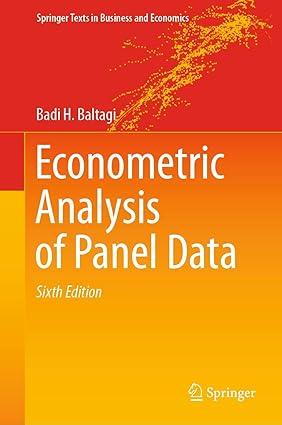The relative efficiency of the Between estimator with respect to the Within estimator. This is based on
Question:
The relative efficiency of the Between estimator with respect to the Within estimator. This is based on problem 99.4.3 in Econometric Theory by Baltagi (1999). Consider the simple panel data regression model
\[\begin{equation*}y_{i t}=\alpha+\beta x_{i t}+u_{i t} \quad i=1,2, \ldots, N ; \quad t=1,2, \ldots, T \tag{1}\end{equation*}\]
where \(\alpha\) and \(\beta\) are scalars. Subtract the mean equation to get rid of the constant
\[\begin{equation*}y_{i t}-\bar{y}_{. .}=\beta\left(x_{i t}-\bar{x}_{. .}ight)+u_{i t}-\bar{u}_{. .}, \tag{2}\end{equation*}\]where \(\bar{x}_{. .}=\Sigma_{i=1}^{N} \Sigma_{t=1}^{T} x_{i t} / N T\) and \(\bar{y}_{. .}\)and \(\bar{u}_{. .}\)are similarly defined. Add and subtract \(\bar{x}_{i}\). from the regressor in parentheses and rearrange\[\begin{equation*}y_{i t}-\bar{y}_{. .}=\beta\left(x_{i t}-\bar{x}_{i .}ight)+\beta\left(\bar{x}_{i .}-\bar{x}_{. .}ight)+u_{i t}-\bar{u}_{. .} \tag{3}
\end{equation*}\]
where \(\bar{x}_{i}=\Sigma_{t=1}^{T} x_{i t} / T\). Now run the unrestricted least squares regression
\[\begin{equation*}y_{i t}-\bar{y}_{. .}=\beta_{w}\left(x_{i t}-\bar{x}_{i.}ight)+\beta_{b}\left(\bar{x}_{i .}-\bar{x}_{. .}ight)+u_{i t}-\bar{u}_{..}\tag{4}\end{equation*}\]
where \(\beta_{w}\) is not necessarily equal to \(\beta_{b}\).
(a) Show that the least squares estimator of \(\beta_{w}\) from (4) is the Within estimator and that of \(\beta_{b}\) is the Between estimator.
(b) Show that if \(u_{i t}=\mu_{i}+u_{i t}\) where \(\mu_{i} \sim \operatorname{IID}\left(0, \sigma_{\mu}^{2}ight)\) and \(u_{i t} \sim \operatorname{IID}\left(0, \sigma_{u}^{2}ight)\) independent of each other and among themselves, then ordinary least squares (OLS) is equivalent to generalized least squares (GLS) on (4).
(c) Show that for model (1), the relative efficiency of the Between estimator with respect to the Within estimator is equal to \(\left(B_{X X} / W_{X X}ight)[(1-ho) /(T ho+\) \((1-ho))]\), where \(W_{X X}=\Sigma_{i=1}^{N} \Sigma_{t=1}^{T}\left(x_{i t}-\bar{x}_{i}ight)^{2}\) denotes the Within variation and \(B_{X X}=T \Sigma_{i=1}^{N}\left(\bar{x}_{i .}-\bar{x}_{. .}ight)^{2}\) denotes the Between variation. Also, \(ho=\sigma_{\mu}^{2} /\left(\sigma_{\mu}^{2}+ight.\) \(\sigma_{u}^{2}\) ) denotes the equicorrelation coefficient.
(d) Show that the square of the \(t\)-statistic used to test \(H_{0} ; \beta_{w}=\beta_{b}\) in (4) yields exactly Hausman (1978) specification test. See solution 99.4.3 in Econometric Theory by Gurmu (2000).
Step by Step Answer:






